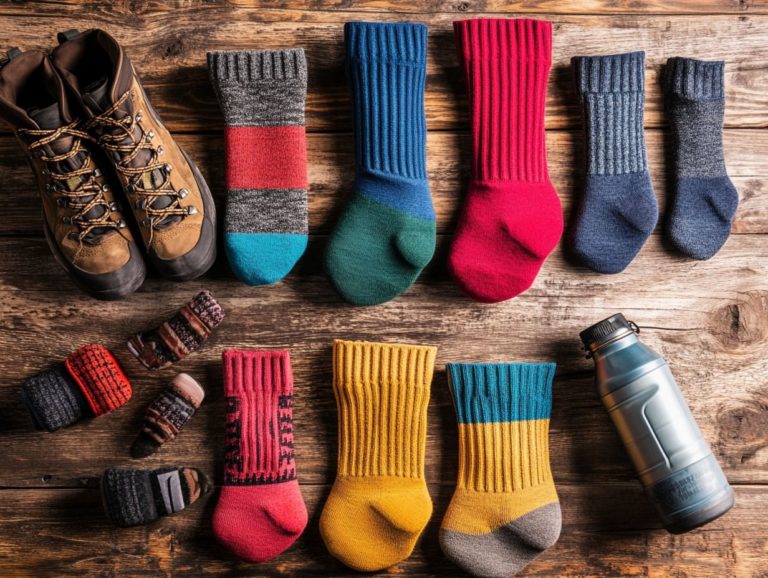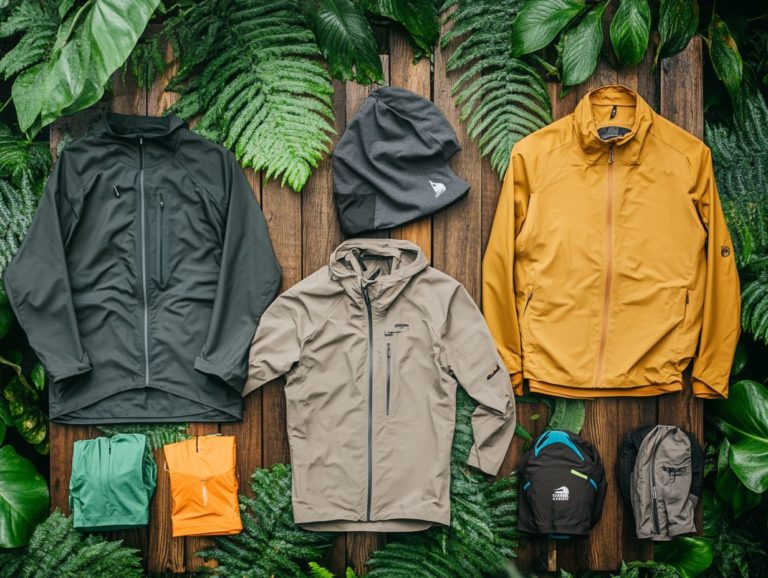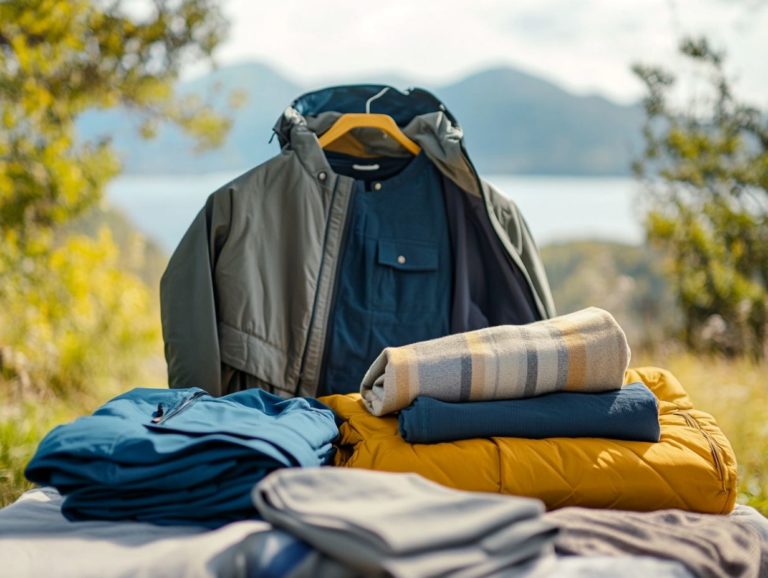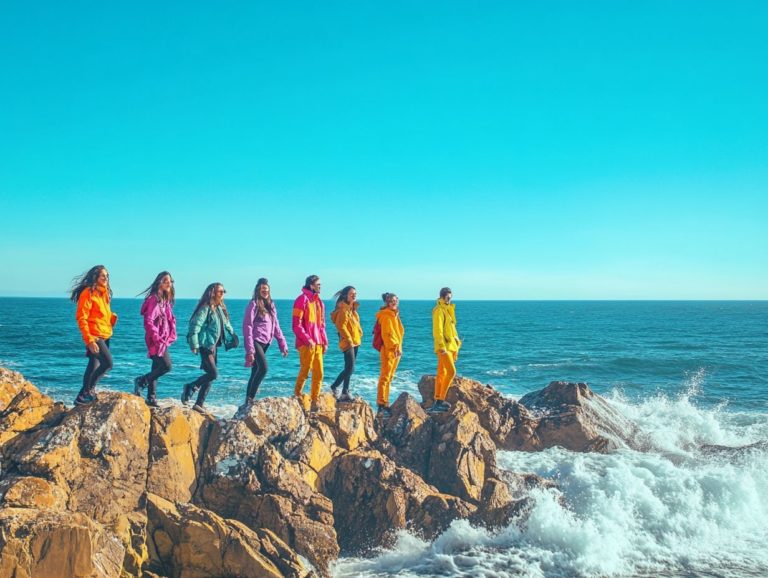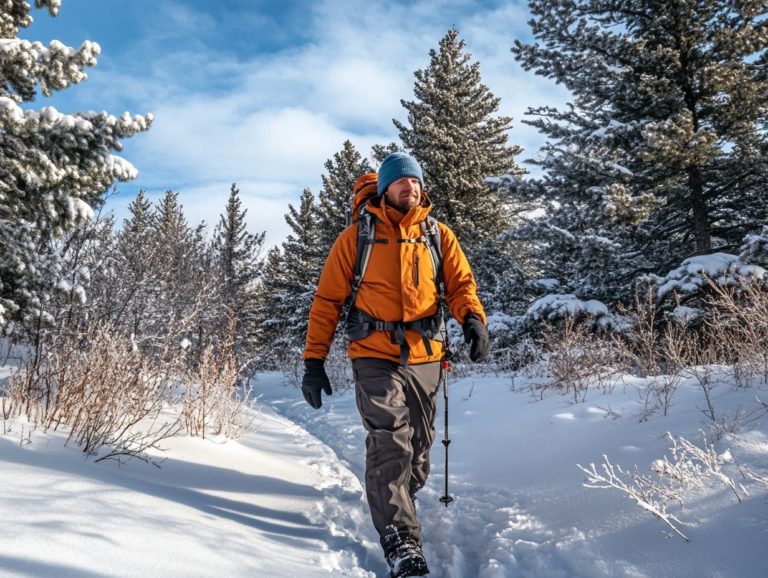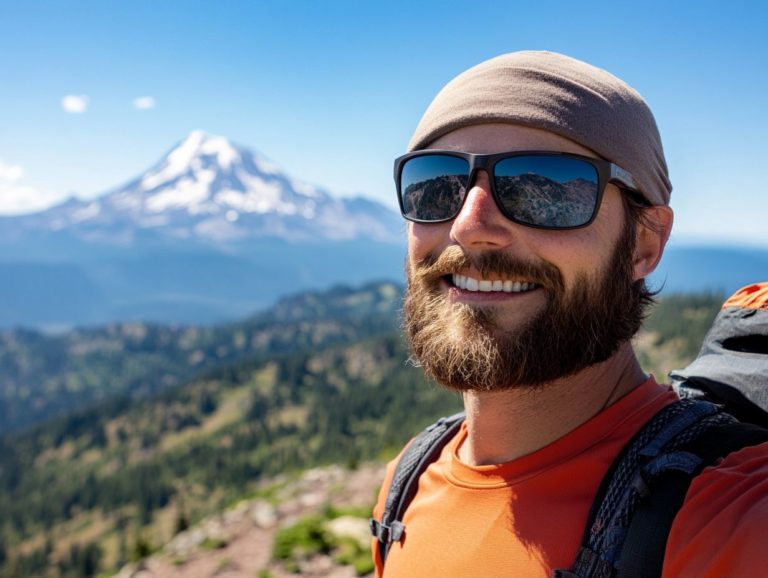The Best Outdoor Clothing for Long-Distance Hiking
Planning a long-distance hike? The right clothing can truly make or break your experience.
Comfort and durability are essential, especially when you are miles away from civilization.
This guide covers everything you need to know. From breathable fabrics and layering techniques to selecting the perfect hiking boots, we ve got you covered.
Whether you’re a seasoned hiker or just starting out, these insights will keep you comfortable and prepared for whatever the trail has in store, especially on challenging routes like the Alpe Adria Trail. Get ready to explore ways to outfit yourself for an unforgettable adventure!
Contents
- Key Takeaways:
- 1. Comfort and Durability Should Be Top Priorities
- 2. Choose Breathable and Moisture-Wicking Fabrics
- 3. Layering Is Key for Changing Weather Conditions
- 4. Consider the Weight and Packability of Clothing
- 5. Opt for Quick-Drying Materials
- 6. Protect Yourself from the Sun
- 7. Invest in Quality Hiking Boots or Shoes
- 8. Don’t Forget About Socks and Undergarments
- 9. Bring a Waterproof and Windproof Jacket
- 10. Consider the Terrain and Activities You’ll Be Doing
- 11. Don’t Overlook Accessories
- 12. Consider Versatility and Multi-Use Items
- 13. Pay Attention to Fit and Comfort
- 14. Don’t Sacrifice Safety for Style
- 15. Don’t Forget to Pack a Hat and Sunglasses
- Frequently Asked Questions
- What clothing will keep you comfortable on long hikes?
- What should you look for in hiking socks?
- Do you need to invest in expensive outdoor clothing?
- What is the best way to dress in layers for long-distance hiking?
- Are there any specific features I should look for in hiking pants?
- What type of footwear is recommended for long-distance hiking?
Key Takeaways:
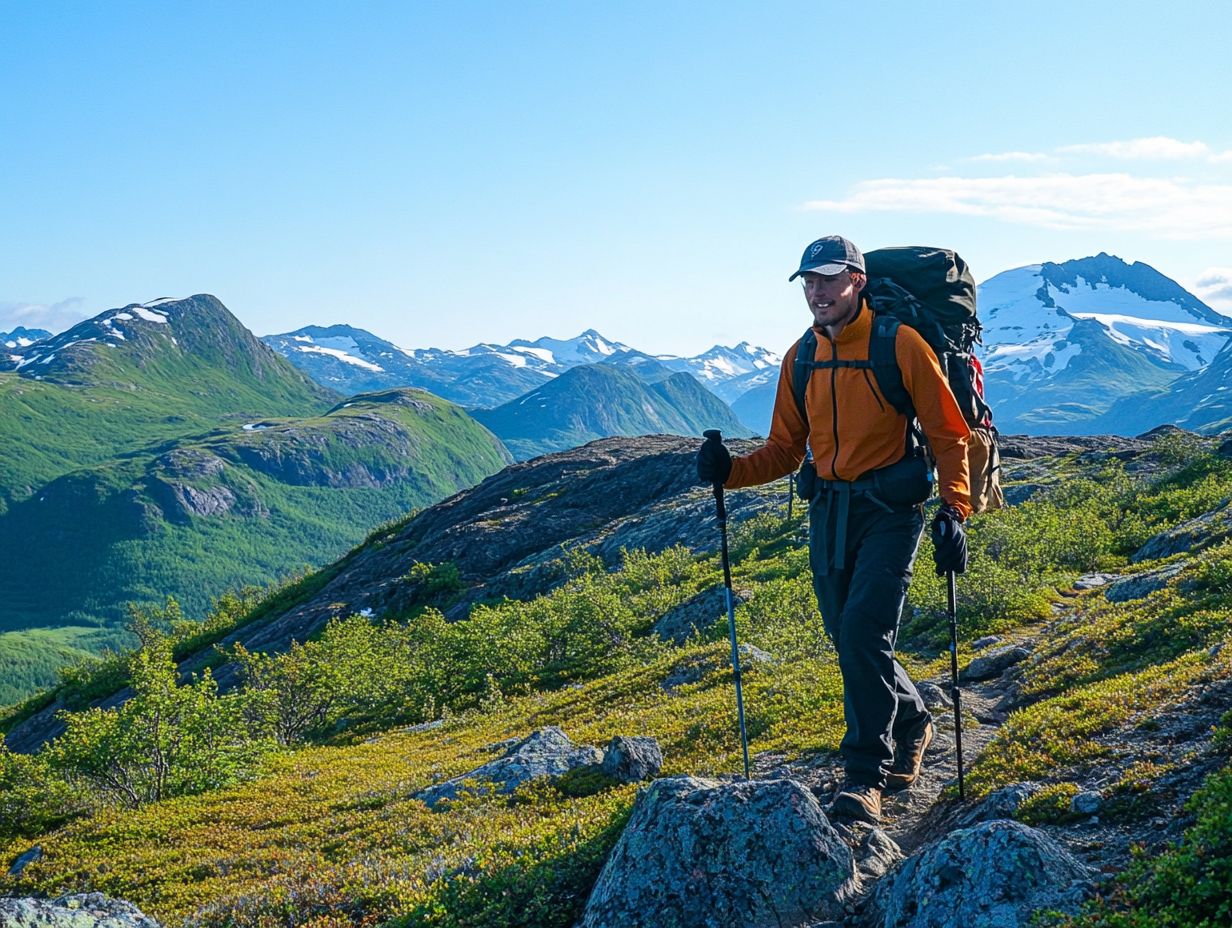
1. Comfort and Durability Should Be Top Priorities
On a long-distance hike, comfort and durability in your gear are key. They ensure a safe and enjoyable experience no matter the weather or terrain.
Investing in quality materials like merino wool and fleece jackets can enhance your journey. Merino wool keeps you dry and warm, while fleece provides lightweight insulation.
Brands like Patagonia have earned a stellar reputation for crafting hiking gear that can withstand the rigors of the outdoors. Their products promise durability and emphasize comfort, allowing you to embrace the elements with confidence throughout your adventure.
2. Choose Breathable and Moisture-Wicking Fabrics
Selecting breathable and moisture-wicking fabrics is essential for your hiking wardrobe. These materials play a vital role in managing sweat and keeping you comfortable on challenging trails like the Alpe Adria Trail.
When you embark on outdoor adventures, the right fabric can elevate your experience by allowing your skin to breathe and effectively regulating your body temperature. For example, merino wool is exceptional for its natural moisture-wicking properties and impressive thermal insulation. You ll stay warm during crisp morning hikes while remaining cool as the sun rises higher.
Brands like Columbia offer outstanding options for hikers keen on investing in high-quality apparel crafted from advanced materials. These fabrics often resist odors, adding convenience during extended trips, so you can focus on the adventure rather than your gear. Additionally, having the best survival gear for day hikes can enhance your experience and ensure safety on the trails.
3. Layering Is Key for Changing Weather Conditions
Layering your clothing effectively is essential for navigating changing weather conditions while hiking. This technique helps you regulate your temperature and maintain comfort as you traverse various terrains.
The core concept of layering consists of three key components: the base layer wicks moisture away from your skin, keeping you dry; the second layer provides insulation by trapping body heat; and the outer layer shields you from elements like wind and rain.
Fleece jackets make for excellent second layers, delivering warmth without adding bulk, while windbreakers function as reliable outer layers, guarding you against chilly gusts. When gearing up for your hiking adventure, consider the weather at your destination.
In warmer locales, lighter base layers paired with breathable outer garments may suffice. However, in colder, unpredictable environments, opting for thicker insulation and waterproof materials could be key to a truly comfortable experience.
4. Consider the Weight and Packability of Clothing
When preparing for a long-distance hike, it s essential to think about the weight and packability of your clothing and gear. Opting for lighter options can significantly enhance your comfort and energy levels on the trail.
By selecting garments made from lightweight materials, you can reduce fatigue and improve your mobility, making each step feel effortless. Brands like Patagonia and Columbia have fantastic lightweight choices, featuring packable jackets and moisture-wicking shirts tailored for outdoor enthusiasts.
These products not only shield you from the elements but also compress easily into your backpack, ensuring that every ounce matters. You ll enjoy breathtaking views instead of feeling weighed down by heavy gear.
5. Opt for Quick-Drying Materials
Quick-drying materials are a game-changer for your hike! Choosing quick-drying materials for your hiking clothing is essential, especially when you encounter unexpected weather changes or plan to cross streams during your adventures. These fabrics offer significant advantages, ensuring you remain comfortable and dry, even in the dampest conditions.
For instance, materials like polyester and nylon are specifically designed to pull moisture away from your skin, allowing for rapid evaporation. Brands like Schoeffel provide hiking pants and tops that incorporate these quick-drying technologies, enabling you to tackle unpredictable climates without the burden of soggy clothing.
Lightweight options, such as merino wool blends, can regulate your temperature and stay odor-free during long treks, making them ideal companions for your journeys into nature.
6. Protect Yourself from the Sun
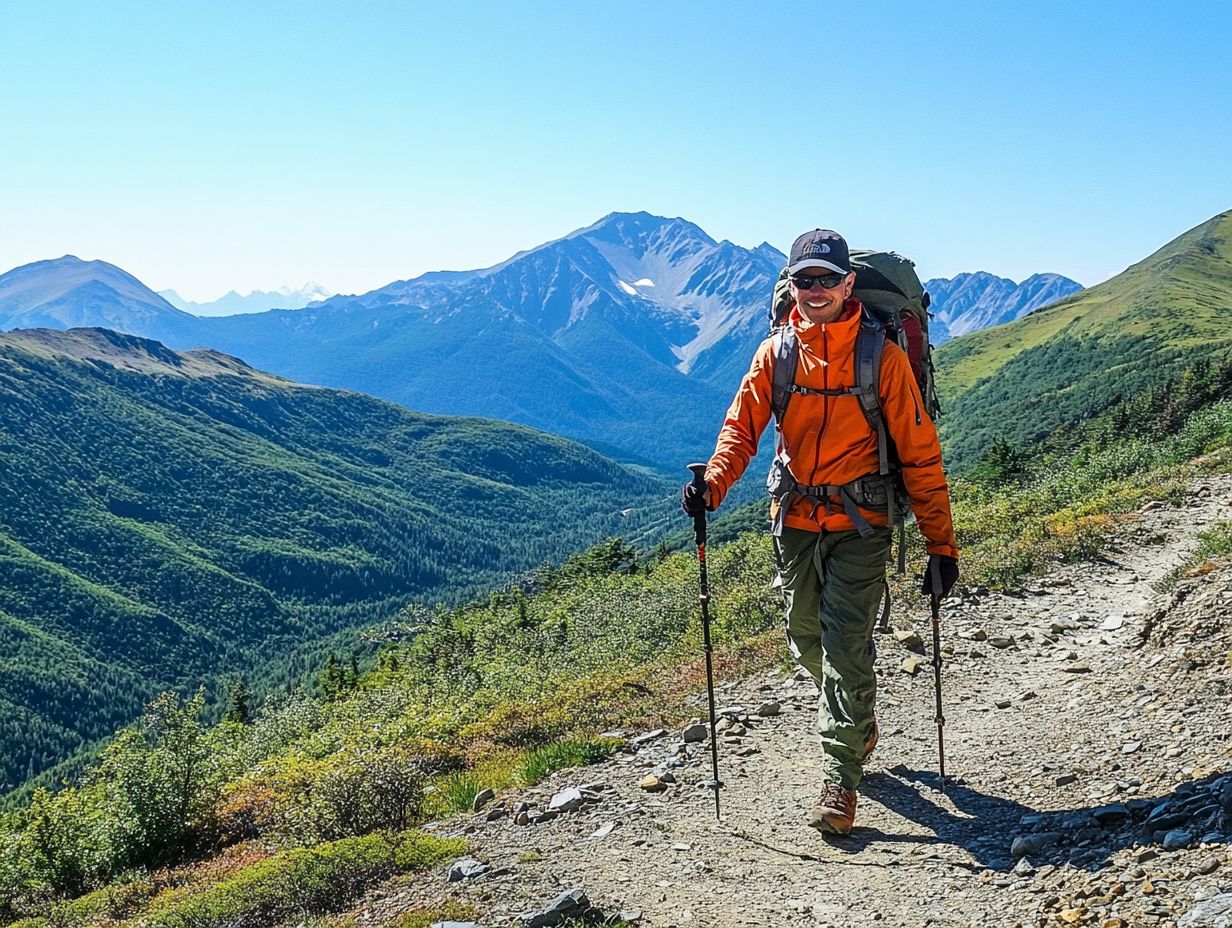
Effective sun protection is crucial while hiking, as extended exposure to UV rays can lead to serious health complications. It s essential to wear appropriate clothing and accessories to safeguard yourself.
Choosing sun-protective clothing, like long-sleeve shirts and wide-brimmed hats, dramatically lowers your risk of sunburn and skin damage. Cover as much skin as you can, particularly during peak sunlight hours.
Applying a broad-spectrum sunscreen to any exposed skin adds an important layer of defense against those harmful UV rays. Brands such as Columbia and Patagonia offer excellent UV-protective gear that combines functionality with style, ensuring you look good while staying safe.
Regarding effective sunscreens, Coppertone and Neutrogena are popular choices, allowing you to enjoy your outdoor adventures with peace of mind.
7. Invest in Quality Hiking Boots or Shoes
Investing in quality hiking boots or shoes is essential for your comfort and safety on the trails; they provide the support and protection needed for various terrains.
When selecting the perfect pair, it’s important to consider features such as waterproofing to keep your feet dry in wet conditions, traction to ensure grip on slippery surfaces, and ankle support to help prevent injuries on rugged paths.
Brands like On Running and Black Diamond have built strong reputations for crafting high-quality hiking footwear that incorporates these vital features, making them a top choice for outdoor enthusiasts like yourself.
Grasping these attributes can greatly enhance your hiking experience, enabling you to tackle longer distances with confidence and ease.
8. Don’t Forget About Socks and Undergarments
While often overlooked, the right socks and undergarments are crucial to enhancing your hiking experience, significantly contributing to your overall comfort while preventing blisters and chafing.
Opting for moisture-wicking socks is essential if you want to elevate your outdoor adventures. These materials draw sweat away from your skin, ensuring your feet stay dry and comfortable throughout those lengthy hikes. Brands like Darn Tough and Smartwool provide top-notch options specifically engineered to wick away sweat. For a successful multi-day hiking trip, consider what to wear to ensure you’re fully prepared. The perfect fit of these socks keeps them securely in place, minimizing friction and reducing the risk of those dreaded, painful blisters.
Choosing the right materials often a blend of merino wool or synthetic fibers allows you to enjoy not just unparalleled comfort but also effective temperature regulation. This makes your journey much more enjoyable, letting you fully immerse yourself in the breathtaking scenery that surrounds you.
9. Bring a Waterproof and Windproof Jacket
Bringing a waterproof and windproof jacket is crucial for any hiking adventure. It offers essential protection against unexpected weather changes, helping you stay dry and comfortable.
A good jacket protects against rain and wind. It also helps keep you cool by letting sweat escape. Look for features like adjustable hoods and cuffs that trap warmth when needed while ensuring the fabric allows moisture to escape.
Packability is a key consideration. A great jacket should fold down easily into a compact size, fitting seamlessly into your backpack without taking up valuable space. Brands like Patagonia and Schoeffel are known for their high-quality offerings, blending modern technology with durable materials to deliver peak performance in various conditions.
10. Consider the Terrain and Activities You’ll Be Doing
Considering the terrain and activities you’ll encounter during your hiking trip is essential for selecting the right gear and clothing. Different environments require specialized equipment.
The type of landscape significantly influences your choices. Rocky paths call for durable footwear with excellent grip. Wet climates demand waterproof pants to keep you dry. In mountains, layering is crucial since temperatures can change dramatically with elevation.
For warmer trails, choose light, breathable materials. For chillier conditions, heavier fabrics may be necessary. Be sure to pack the right accessories, like moisture-wicking socks and sun protection, as they will take your hiking experience to the next level! To learn more about how hiking apparel has changed over time, check out the evolution of hiking clothing.
11. Don’t Overlook Accessories
Accessories often fly under the radar, yet they play an essential role in enhancing your comfort and safety during hikes. Think of items like gloves, scarves, and trekking poles they’re far from mere afterthoughts.
These essentials do more than shield you from the elements; they elevate your entire hiking experience. When you’re navigating chilly mountain trails, a sturdy pair of thermal gloves and a wind-resistant scarf will be your best allies against the biting cold.
In warmer climates, breathable hats and moisture-wicking clothing become crucial for maintaining your comfort. As you tackle rugged terrains, investing in high-quality trekking poles can drastically reduce strain on your joints and improve stability.
Don t overlook a reliable hydration pack, which is a backpack with a water reservoir, to keep water easily accessible and help fend off fatigue and dehydration.
12. Consider Versatility and Multi-Use Items
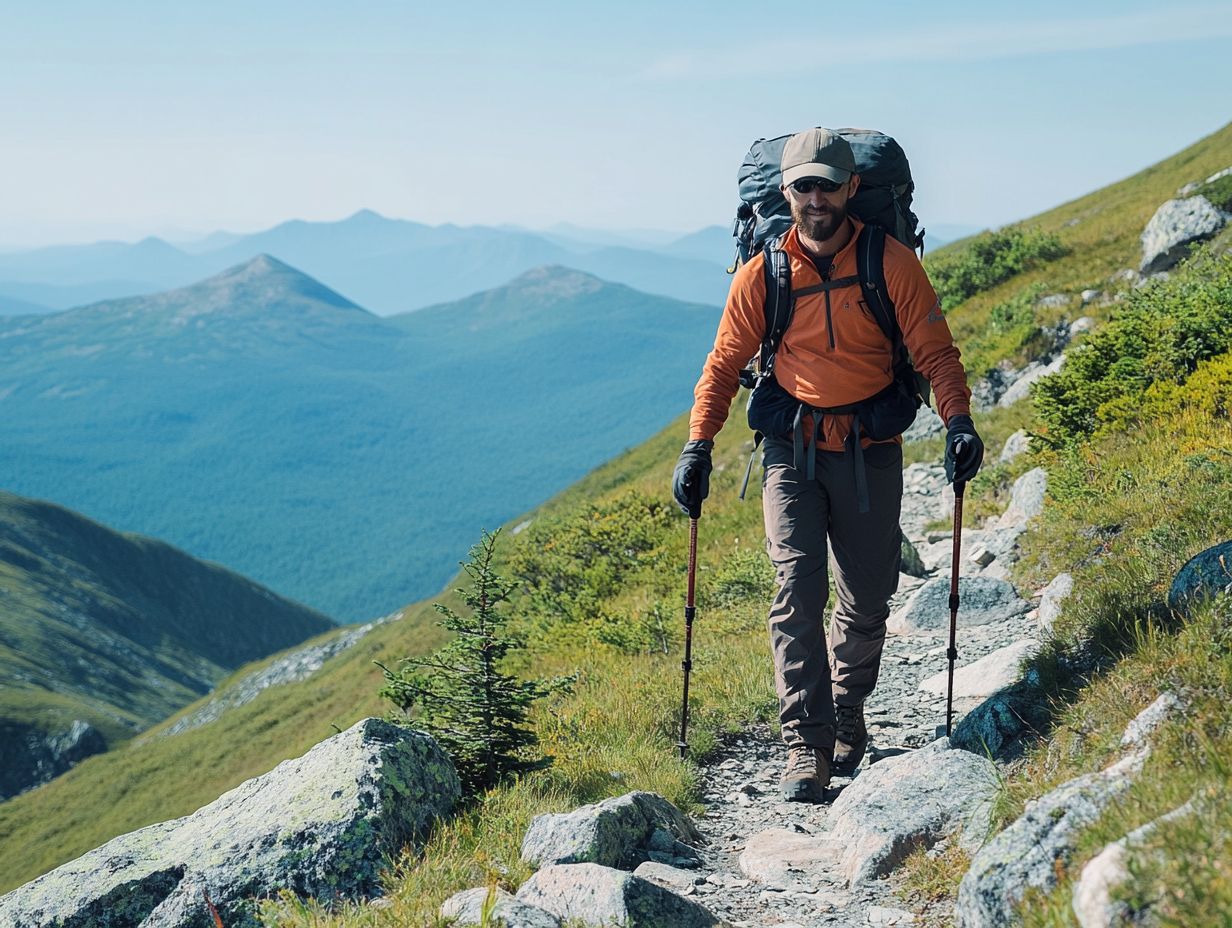
When you re gearing up for a hike, embracing versatility and multi-use items can significantly lighten your load while ensuring you re equipped for a variety of conditions.
Take a lightweight jacket, for example. Not only does it provide warmth during cooler weather, but it also serves as a dependable windbreaker when the winds whip up. This kind of dual functionality is crucial for any outdoor aficionado.
Similarly, consider packing swimwear that can double as active wear. This allows for a smooth transition from a hiking trail to an impromptu dip in a nearby lake. By choosing clothing that adapts to different activities, you can enjoy a more streamlined packing experience while being fully prepared for whatever adventures come your way.
13. Pay Attention to Fit and Comfort
Ensuring your hiking clothing fits well and feels comfortable is essential. It directly influences your performance and enjoyment during longer treks.
When planning your outdoor adventure, trying on various clothing layers is crucial. This helps you understand how each piece fits and interacts with the others. Evaluate mobility and breathability, as a well-designed layering system can effectively regulate your body temperature, enhancing overall comfort.
Remember, comfort is more than just a pleasant sensation; it plays a pivotal role in your performance. It helps reduce fatigue and distractions along the trail.
To discover the perfect fit, take accurate measurements of your body and test garments while moving. This approach can significantly elevate your hiking experience, ensuring that every trek is enjoyable and successful.
14. Don’t Sacrifice Safety for Style
Looking stylish is appealing, but make sure you don t sacrifice safety for aesthetics when selecting your hiking gear; functionality should always come first.
When you choose the right gear, consider how well it performs under various weather conditions and terrains, rather than solely focusing on appearance. Whether you’re trekking through slippery trails or navigating rocky paths, having durable materials and reliable features can greatly enhance your experience.
As you venture into the wilderness, remember that true style comes from being well-equipped. This allows you to achieve a harmonious blend of comfort and protection. This approach maximizes your enjoyment during outdoor activities while minimizing risk, ensuring that every adventure is as safe as it is stylish.
15. Don’t Forget to Pack a Hat and Sunglasses
Don t forget your hat and sunglasses they re your best friends on sunny hikes! Packing these accessories is critical for sun protection and can significantly enhance your comfort.
A wide-brimmed hat provides excellent shade for your face and neck, dramatically reducing the risk of sunburn and skin damage. A baseball cap effectively shields your eyes, too.
When picking sunglasses, always choose ones that offer 100% UV protection and wraparound designs for maximum defense against harmful rays. These accessories help maintain comfort by minimizing glare and preventing overheating. They also play a crucial role in reducing the likelihood of long-term health issues, such as cataracts and skin cancer.
Together, they form a protective barrier, ensuring your outdoor adventures remain enjoyable and safe.
How Can One Strike a Balance Between Comfort and Functionality?
Striking a balance between comfort and functionality is essential for long-distance hiking. It ensures you remain well-equipped and at ease throughout your journey.
To achieve this balance, consider several strategies when evaluating your gear. First, try on equipment before purchasing; this allows you to gain insights into fit and comfort under various conditions. Opt for adjustable features, like padded shoulder straps and waist belts, which can enhance your comfort during extended wear.
Using trekking poles designed with ergonomic grips can minimize strain on your hands and wrists. A well-fitted backpack especially those with moisture-wicking lumbar support helps maintain stability and prevents back pain. (Moisture-wicking means the fabric pulls sweat away from your skin to keep you dry.)
Test your footwear on different terrains to ensure they provide the right cushioning and support. This effectively prevents blisters and fatigue during those long hikes.
What Are Some Essential Items for Layering?
Essential items for layering include a quality base layer, an insulating mid-layer, and a protective outer layer. Each plays a specific role in temperature regulation and comfort.
The base layer, typically crafted from sweat-resistant materials like merino wool or synthetic fabrics, manages sweat and keeps your skin dry. The insulating mid-layer should be made from materials like fleece or down, providing warmth without adding bulk and allowing you the freedom to move.
A durable outer layer is critical for shielding against wind, rain, and snow. Look for high-performance options from trusted brands like Patagonia and The North Face.
Selecting the right fit enhances your comfort and ensures optimal air circulation, allowing each layer to do its job effectively.
How Can One Pack Light Without Sacrificing Essential Items?
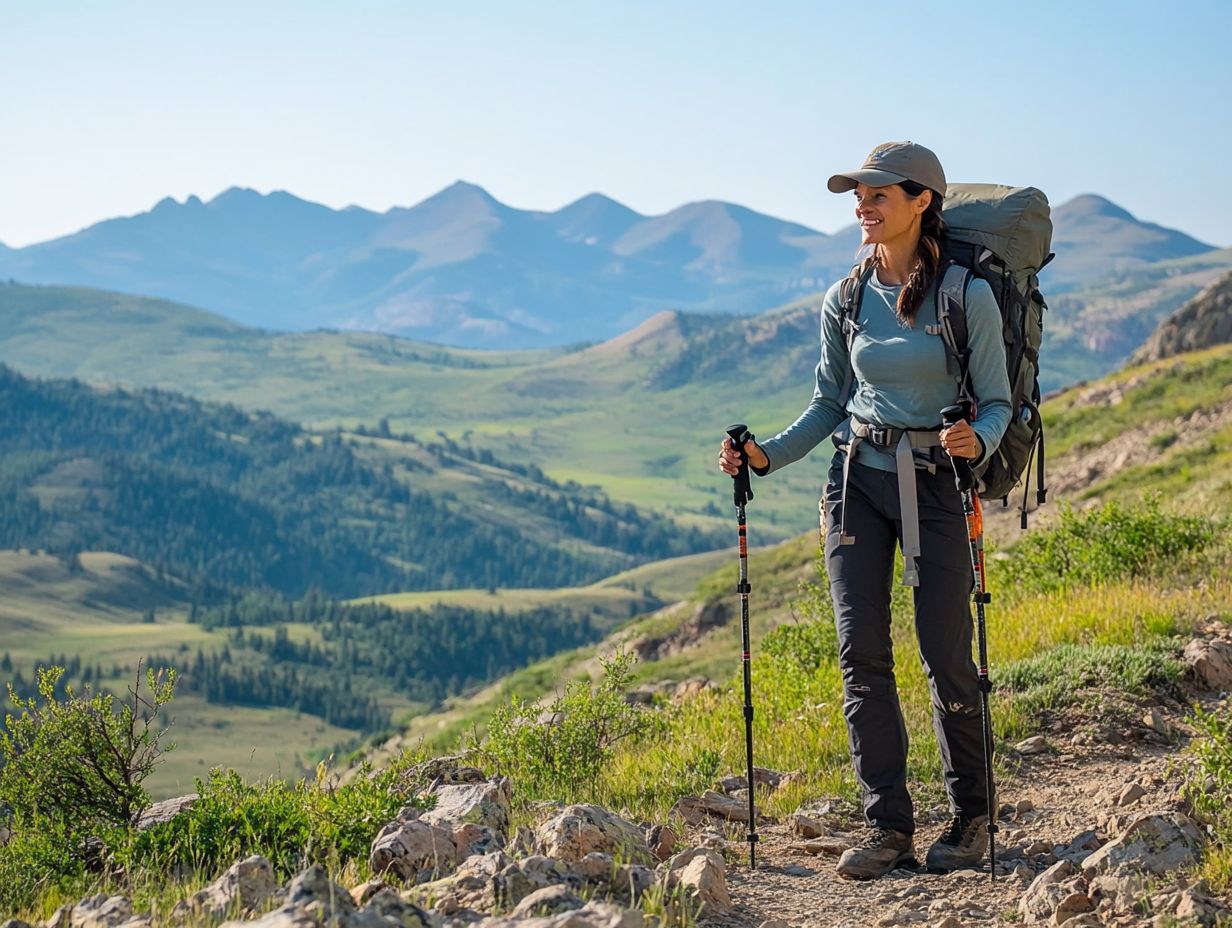
Packing light while ensuring you have all the essentials is a skill that will elevate your hiking experience, minimizing fatigue and enhancing agility on the trail.
To master this art, think strategically about your gear choices. By selecting items that serve multiple purposes, you can lighten your pack without sacrificing functionality. For instance, a lightweight jacket can function as both a windbreaker and a blanket, while versatile footwear can handle various terrains with ease. Incorporate a compact cooking system that allows you to boil water and prepare meals effortlessly.
An effective packing list could include:
- A multi-tool
- A travel-sized first-aid kit
- Collapsible containers
Don’t wait! Always prioritize essentials like a hydration system and energy-rich snacks to fuel your adventure while keeping your load manageable.
What Are Some Tips for Choosing the Right Hiking Boots?
Choosing the right hiking boots can make or break your adventure! They are crucial for ensuring your comfort and support on the trail. Ill-fitting shoes can turn long treks into discomfort and potential injuries.
When selecting hiking boots, consider key factors such as fit, terrain type, and support features. The boots should embrace your foot snugly without being constrictive, allowing for ample toe movement while preventing blisters.
Different terrains require varying sole robustness and specific tread patterns to provide optimal traction. Look for support features like ankle height and cushioning, as these can significantly enhance your stability.
To truly test the boots, stroll around the store, simulate uphill and downhill movements, and try them on with the socks you plan to wear. This ensures they feel fantastic even after several minutes of wear.
Frequently Asked Questions
For the best experience, don’t forget to carry items such as a sleeping bag and a proper emergency kit.
What clothing will keep you comfortable on long hikes?
The best outdoor clothing for long-distance hiking includes moisture-wicking and quick-drying materials, such as merino wool or synthetic fabrics. It’s also important to have clothing that protects from the sun and elements, such as shirts with Ultraviolet Protection Factor (UPF) ratings and rain gear.
What should you look for in hiking socks?
When choosing hiking socks, opt for those made of moisture-wicking materials with cushioning for comfort and the appropriate height for your hiking shoes. A snug fit helps prevent blisters.
Do you need to invest in expensive outdoor clothing?
While higher-priced outdoor clothing may offer advanced technology and features, it’s not always necessary for long-distance hiking. Look for sales, clearance items, or consider renting gear for your trip.
What is the best way to dress in layers for long-distance hiking?
The key to dressing in layers for long-distance hiking is to start with a moisture-wicking base layer, add an insulating mid-layer, and top it off with a waterproof outer layer. This allows you to adjust your clothing as needed for changing weather and activity levels.
Ready to hit the trails? Choose your gear wisely and make the most of your hiking experience!
Are there any specific features I should look for in hiking pants?
Look for hiking pants made from lightweight and breathable materials. Quick-drying fabric is also essential for comfort.
Bonus features to consider include zip-off legs for versatility and multiple pockets for all your gear. Extra support at the knees adds durability for tough trails.
What type of footwear is recommended for long-distance hiking?
The right footwear can make or break your hiking adventure! Choose based on your personal comfort and the terrain.
Hiking boots offer great ankle support and stability. If you prefer something lighter, trail runners are flexible options, while hiking sandals are perfect for warm weather and water crossings.

